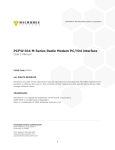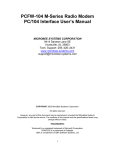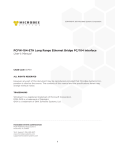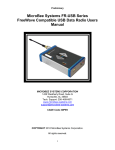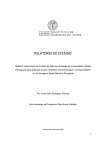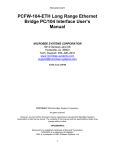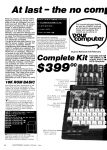Download Microbee Systems MBS-GPS-SS2-5HZ User`s manual
Transcript
preliminary COPYRIGHT 2011 MicroBee Systems Corporation. MBS-GPS Novatel SSII & OEMV-1 PC/104 GPS Module User’s Manual CAGE Code 3DPE9 ALL RIGHTS RESERVED However, any part of this document may be reproduced, provided that MicroBee Systems Corporation is cited as the source. The contents of this manual and the specifications herein may change without notice. TRADEMARKS Windows® is a registered trademark of Microsoft Corporation. ROM-DOS is a trademark of Datalight. QNX is a trademark of QNX Software Systems, Ltd ...................................................................................................................................... MICROBEE SYSTEMS CORPORATION 1429 Weatherly Road, Suite G Huntsville, AL 35803 Tech. Support: 256–489-6671 www.microbee-systems.com [email protected] 1 REV B preliminary NOTICE TO USER . . . . . . . . . . . . . ............................................................................................. . . . . . The information contained in this manual is believed to be correct. However, MicroBee Systems assumes no responsibility for any of the circuits described herein, conveys no license under any patent or other right, and makes no representations that the circuits are free from patent infringement. MicroBee Systems makes no representation or warranty that such applications will be suitable for the use specified without further testing or modification. MicroBee Systems Corporation general policy does not support the use of its products in life support applications where the failure or malfunction of a component may directly threaten life or injury. It is a Condition of Sale that the user of MicroBee Systems products in life support applications assumes the risk of such use and indemnifies MicroBee Systems against all damage. Please read before installing your product MicroBee’s products are designed to be high in performance while consuming very little power. In order to maintain this advantage, CMOS circuitry is used. CMOS chips have specific needs and some special requirements that the user must be aware of. Read the following to help avoid damage to your card from the use of CMOS chips. Using CMOS Circuitry Industrial Control originally used LSTTL circuits. Because many PC components are used in laptop computers, IC manufacturers are exclusively using CMOS technology. Both TTL and CMOS have failure mechanisms, but they are different. This section describes some of the common failures which are common to all manufacturers of CMOS equipment. Improper power causes catastrophic failure If a card has had reverse polarity or high voltage applied, replacing a failed component is not an adequate fix. Other components probably have been partially damaged or a failure mechanism has been induced. Therefore, a failure will probably occur in the future. For such cards, MicroBee highly recommends that these cards be replaced. Other over-voltage symptoms In over-voltage situations, the programmable logic devices, EPROM’s and CPU chips, usually fail in this order. The failed device may be hot to the touch. It is usually the case that only one IC will be overheated at a time. Hot insertion Hot insertion is not supported. Doing so voids your warranty. 2 REV B preliminary PREFACE . . . . . . . . . . . . . ............................................................................................. . . . . . This manual is a guide to the proper configuration, installation, and operation of your MBSGPS PC/104 Interface. For setup and operation of the Novatel SSII or OEMV-1 Manuals included with this product. You can use your MBS-GPS-SS2-5HZ card in conjunction with other PC/104 expansion cards, tailoring your system for a wide variety of applications. TECHNICAL SUPPORT . . . . . . . . . . . . . ............................................................................................. . . . . . MicroBee Systems is committed to supporting our products. For this reason all user manuals as well as this manual are always available online in PDF format at http://www.microbee-systems.com/user_manuals.htm. If you do not find this online then please inform us and we will make it available immediately. This unit has been tested with a number of operating systems including MSDOS, Linux, QNX, Microsoft Windows 98, NT, 2000 and XP. Any operating systems supporting an ISA legacy device should operate normally with this product. This unit defaults to 16C550 mode. Access to advanced features are via register access or jumpers and thus may require modification to existing drivers. MicroBee Systems does not guarantee operation with unusual or custom “in house” operating systems or serial IO libraries. We will help you all we can. If you have a question about the MBS-GPS card and cannot find the answer in this manual, call Technical Support. They will be ready to give you the assistance you need. When you call, please have the following at hand: • • Your MBS-GPS Module Interface User’s Manuals A description of your problem. The direct line to Technical Support is 256-426-2431. OVERVIEW . . . . . . . . . . . . . ............................................................................................. . . . . . The MBS-GPS PC/104 GPS Module is a CPLD based triple high speed 16C850 UART PC/104 Bus Compliant 8 BIT interface based upon the Exar XR16C2850 Dual UART with user selectable 128 Byte deep FIFO buffers and integrated with the Novatel Super Star II 5Hz GPS. This interface provides two independent user inversion selectable TTL and RS232 level 1PPS outputs. Serial Port 1 is used as the Primary Data/Command Port and Port 2 is the Differential input when a RTCM compliant correction message is supplied. Port 3 is a standard high speed serial port available for communications up to 921 kBaud. This unit is available with either the Novatel SSII 3.3V GPS or the high performance Novatel 3 REV B preliminary OEMV-1 3.3V GPS. Once the unit is configured and installed it is treated as three standard serial ports on the PC/104 stack. As an example, if the Data Port is configured for an address of 0x3F8 and IRQ 4 then the MBS-GPS is utilized simply as COM 1. Default operation is 16C550 mode with 16 byte FIFO’s. Wide FIFO enable is via software writes to special registers. Please refer to the XR16C2850 UART datasheet. This unit does not support flow control except on the EXT Serial Port. The interface supports baud rates up to a maximum of 921,600 Baud. However, the Novatel SSII only supports maximum rates of 19,200. Operation with 16 byte FIFO’s is satisfactory at this rate. However, the user can enable FIFO’s up to 128 bytes deep. This means that instead of an interrupt generated every 15 characters one could be generated only once per message greatly reducing overhead on the host processor to handle interrupt servicing. The unit incorporates the 16 bit PC/104 ISA connector so 16 bit devices can be placed on the stack after the radio. Also interrupts 10, 11, 14 and 15 are accessed thru this connector. The MBS-GPS-SS2-5HZ, being an 8 BIT interface, does not require a 16 bit ISA card be prior to the radio unless operation requires IRQ 10, 11, 12, 14 or 15. For more information on the PC-104 ISA bus please refer to the PC-104 specification at: http://www.pc1 04.org/technology/PDF /PC1 04Specv246.pdf Caution The MBS-GPS contains static sensitive CMOS components. The greatest danger occurs when the card is plugged into the PC/104 stack. The card becomes charged by the user and the static discharges to the I/O bus from the pin closest to the card connector. If that pin happens to be an input pin, even TTL inputs may be damaged. Follow sound ESD practices!!!! To avoid damaging your card and its components: Ground yourself before handling the MBS-GPS Module. Disconnect power before removing or inserting the MBS-GPS Module. OPERATING PRECAUTiONS + TECHNICAL SPECIFICATIONS . . . . . . . . . . . . . ............................................................................................. . . . . . Ordering Information Part # MBS-GPS-SSII-5Hz with the Super Star 2 5 Hz OEM GPS. Part # MBS-GPS-OEMV-1 with the Novatel OMEV-1 OEM GPS. No REV # is required. Baud Rate The MBS-GPS is fully 16C850A compliant and supports software selectable baud rates up to 4 REV B preliminary 921,600 baud. The Novatel SSII-5Hz supports a maximum of 19,200 baud. The OEVM-1 supports up to 921,600 baud. Environmental -35° to 70° C operating. -40° to 90° C non-operating. RH 5% to 95%, non-condensing. Power Specification 5V +/– 5% at 100 mA maximum.. Antenna common mode output 50mA Maximum. Size 3.6 in. x 3.8 in x 0.5 in. 91.4 mm X 96.5 mm x 15.2 mm INSTALLATION . . . . . . . . . . . . . ............................................................................................. . . . . . Before installing the MBS-GPS Module, refer to Figure 1 for the location of various rotary switches, connectors and jumpers. Interrupt Selection Switches, SW4, SW8, SW12 The MBS-GPS uses simple and easy to use rotary switches for IRQ selection. Simply place the serial port IRQ switch to the desired setting you want. If you select an invalid IRQ then interrupts are disabled for that port. IRQ’s 3, 4, 5, 6, 7, 9, 10, 11, 12, 14 and 15 are supported. Thus if you select IRQ 1, 2, 8, 13 there is no IRQ enabled for that port. The CPLD simply ignores invalid selections. These can be used for polled mode operation. Simply select the desired IRQ level by rotating the IRQ Selection switch the appropriate position (see Figure 1). Default configuration shown in Figure 1 for SW4 is IRQ4 which is standard for COM1. Default configuration for SW8 is IRQ3 which is standard for COM 2. Each port must use a unique IRQ. Caution Improper IRQ configuration can result in your CPU locking up due to an IRQ conflict. Most COM libraries allow for non-standard IRQ settings as will after market drivers. Windows 95, 98, ME, NT, 2000 and XP may limit your IRQ selection without aftermarket drivers. This is usually not required unless all IRQ’s supported by the OS are already allocated. 5 REV B preliminary Address Selection Rotary Switches For flexibility with most SW and Development libraries this unit will support any valid address between 0x000-0x007 and 0x7F8-0x7FF. However, most platforms have limited IO space. Please refer to your host CPU IO Map for available IO space for this product. Most applications will use one of the common serial port addresses. The most common are: COM1 = 3F8, IRQ4, COM2 = 2F8, IRQ3 COM3 = 3E8, IRQ4 COM4 = 2E8, IRQ3. Figure 1 shoes 0x3f8 for the GPS Data Port, 0x2f8 for the GPS Differential Port and 0x300 for the External Serial Port. This unit is simple to use. Set the selected channel address switches to the IO space you want and the channel is ready to use. Please note, when selecting the LSB of each serial port only bit 3 is changed. Thus a setting of 0 or 8 is valid. Any selection between 0 and 7 (BIT 3 = 0) and 8 and 15 (BIT 3 = 1) has no effect other than to set BIT 3. Confused? This means BIT’s 0-2 are masked and have no effect on the base address. ISA IO blocks are assigned in 8 byte blocks. Thus a base address of 0x3f0 or 0x3f8 makes sense. However, a base address of 0x3f9 does not. Address bits 0-2 are routed directly to the UARTS and are not used in base IO address decoding. Only bits 3 to 15 are used for address decoding. So if you set the rotary switches to an IO space of 0x3f9 the device still maps to a base IO of 0x3f8. Internal or Auxiliary 1 Pulse Per Second (1PPS) Selection, JP1 JP1 Controls the 1PPS source and HW or SW control of the source. In position SW the 1PPS signal is routed based upon the level of the RTS line of the Data Port. Thus if the data port is COM1 (0x3F8) then setting the RTS bit of COM1 to 1 will select the AUX PPS input and setting the RTS bit to 0 will select the GPS. In position JP the data, PPS signal and Reset lines are routed based upon Jumper JP1, not the RTS bit of the Data Port. JP1A GPS selects the Novatel SSII for the 1PPS source and JP1A AUX selects the AUX for the 1PPS source. PPS Output Signal Inversion, JP2 & JP3 There are two PPS Outputs available. One is RS-232 level and the other is TTL Level. JP2 and JP3 control the inversion of the respective PPS outputs as well as allow either jumper settings or software control of the inverters. JP2 controls the RS-232 level inversion exclusively. The SW position allows inversion to be set by the RTS1 BIT of the Differential Port. The JP position selects jumper control. N = Normal or Un-Inverted, I = Inverted. JP3 controls the TTL level inversion exclusively. The SW position allows inversion to be set by the RTS1 BIT of the Differential Port. The JP position selects jumper control. N = Normal or 6 REV B preliminary Un-Inverted, I = Inverted. RTS1 Inverts or un-inverts the RS-232 1PPS signal output. Bit set = invert. DTR0 Inverts or un-inverts the TTL 1PPS signal output. Bit set = invert. STATUS MONITORING . . . . . . . . . . . . . ............................................................................................. . . . . . Overview Several status features are available. These are provided to monitor the 1PPS timing pulse from either the GPS or the AUX 1PPS source. The 1PPS is primarily used for synchronization of MicroBee Systems PC/104 FreeWave data radio products in Masterless TDMA mode and Push To Talk (PTT) mode. In addition the 1PPS is very useful for timetag and system synchronization functions by providing a very precise time mark. For these reasons advanced features allow an AUX PPS, primarily for software development without a valid GPS signal, and polarity inversion of the signals should a system/device require this. Additionally the 1PPS output is available in both TTL and RS-232 Levels. Please refer to the section on J6 for further information. DSR0 of the Data Port monitors the GPS 1PPS or AUX before the 1PPS inversion capabilities. In other words, this is direct from the GPS or AUX. RI0 of the Data Port monitors the 1PPS before the inversion circuitry. Comparison of this BIT can be used to help verify inversion is set. RI1 of the Diff Port monitors the RS-232 1PPS after the inversion circuitry. If the 1PPS is noninverted then this will be identical to DSR0 & RI0. If inversion of the 1PPS is selected then this will be the compliment of DSR0 & RI0. CD0 of the Data Port monitors the TTL 1PPS after the inversion circuitry. If the 1PPS is non-inverted then this will be identical to DSR0 & RI0. If inversion of the 1PPS is selected then this will be the compliment of DSR0 & RI0. CTS0 of the Data Port is used to monitor the AUX PPS in. If the AUX PPS is unused then this should be ignored. This is used to monitor for the presence of an AUX PPS signal. 7 REV B preliminary NOTE If AUX PPS is selected then the these features will work upon the AUX signal instead of the GPS signal. The AUX is primarily used for software development of systems requiring a 1PPS interrupt where no GPS signal is available as GPS systems may not provide a 1PPS without a valid fix. TABLE 1 SIGNAL FUNCTION STATUS LINE FUNCTION DTR1 Reset Line for GPS or Ext device at J7 CD1 TTL Discreet input, active low, J6.4 DSR1 TTL Discreet input, active low, J6.5 CTS1 TTL Discreet input, active low, J6.6 DSR0 1PPS Presence monitor (source independent) CTS0 Aux 1PPS Input monitor RTS0 1PPS Source Selection, GPS or Aux In RI0 1PPS Monitor (Always shows PPS source state) RI1 1PPS RS-232 Post inversion circuit monitor (Shows if RS-232 PPS is inverted or un-inverted. CD0 1PPS TTL2 Post inversion circuit monitor (Shows if TTL PPS is inverted or un-inverted. RTS1 Inverts or un-inverts the RS-232 1PPS signal output. Bit set = invert. DTR0 Inverts or un-inverts the TTL 1PPS signal output. Bit set = invert. PPS Active LED The PPS LED flashes when a PPS signal is valid from the GPS or the AUX PPS input. The CPLD detects the rising edge of the PPS signal and turns on the LED until a counter expires. Thus the LED ON duration is independent of the PPS Pulse Width. 8 REV B preliminary PPS IO Connector, J6 Terminal Block J6 is the IO for the 1PP signal. The pinouts are as follows: J6.1 1PPS Output. This represents the 1PPS output in RS-232 level. This signal depends upon the source and polarity selection as described previously. J6.2 TTL level 1PPS output. It is identical to J6.1 except it is TTL level and can be inverted independently of J6.1. J6.3 This is the AUX PPS input. This input accepts RS-232 level signals. It is important to remember that if used with a TTL source you must invert the signal. This is because RS-232 level signals are inverted relative to TTL (MARK = -5V and SPACE = +5V). A TTL Level 0VDC will trigger a RS-232 level input to MARK. J6.4 DCD1, this is the Data Carrier Detect input of the Differential Port UART. It is available as a discreet TTL level input. These are active low inputs and are pulled to +5V. J6.5 DSR1, this is the Data Set Ready input of the Differential Port UART. It is available as a discreet TTL level input. These are active low inputs and are pulled to +5V. J6.6 CTS1, this is the Clear To Send input of the Differential Port UART. It is available as a discreet TTL level input. These are active low inputs and are pulled to +5V. J6.7 +5VDC, un-fused. This is available to power external devices. Caution, this is an unprotected 5VDC output. J6.8 GND, This is the J6 signal ground. 9 REV B preliminary J7, EXT RS-232 Serial Port J7 is a standard 16C850 128 byte FIFO serial port with the exception that it supports baud rates up to 921 kbaud 1. DCD 2. DSR 3. RXD 4. RTS 5. TXD 6. CTS 7. DTR 8. RI 9. GND 10. N.C. Figure 1 IO Layout . . . . . . . . . . . . . ............................................................................................. . . . . . 10 REV B preliminary Figure 2 Functional Diagram . . . . . . . . . . . . . ............................................................................................. . . . . . 11 REV B preliminary Figure 3 1PPS Selection Logic . . . . . . . . . . . . . ............................................................................................. . . . . . 12 REV B preliminary Figure 4 TTL Level 1PPS Inversion Logic . . . . . . . . . . . . . ............................................................................................. . . . . . 13 REV B preliminary Figure 5 RS-232 Level 1PPS Output Inversion Logic . . . . . . . . . . . . . ............................................................................................. . . . . . 14 REV B preliminary Figure 6 1PPS Monitoring Schema . . . . . . . . . . . . . ............................................................................................. . . . . . 15 REV B preliminary WARRANTY . . . . . . . . . . . . . ............................................................................................. . . . . . MicroBee Systems Corporation (MicroBee), warrants that it’s standard hardware products will be free from defects in materials and workmanship under normal use and service a period of one year from date of purchase. MicroBee’s obligation under this warranty shall not begin until Buyer returns the defective product, freight prepaid to MicroBee’s facility or another specified location. MicroBee’s only responsibility under this warranty is, at its option, to replace or repair, free of charge, any defective component part of such products. LIMITATIONS ON WARRANTY The warranty set forth above does not extend to and shall not apply to: 1. Products, including software, which have been repaired or altered by other than MicroBee personnel, unless Buyer has properly altered or repaired the products in accordance with procedures previously approved in writing by MicroBee. 2. Products which have been subject to power supply reversal, misuse, neglect, accident, or improper installation. 3. The design, capability, capacity, or suitability for use of the Software. Software is licensed on an ”AS IS” basis without warranty. The warranty and remedies set forth above are in lieu of all other warranties expressed or implied, oral or written, either in fact or by operation of law, statutory or otherwise, including warranties of merchantability and fitness for a particular purpose, which MicroBee specifically disclaims. 4. MicroBee neither assumes nor authorizes any other liability in connection with the sale, installation or use of its products. MicroBee shall have no liability for incidental or consequential damages of any kind arising out of the sale, delay in delivery, installation, or use of its products. SERVICE POLICY 1. MicroBee’s goal is to ship your product within 10 working days of receipt. 2. If a product should fail during the warranty period, it will be repaired free of charge. For out of warranty repairs, the customer will be invoiced for repair charges at current standard labor and materials rates. 3. Customers that return products for repairs, within the warranty period, and the product is found to be free of defect, may be liable for the minimum current repair charge. 16 REV B preliminary RETURNING A PRODUCT FOR REPAIR Upon determining that repair services are required, the customer must: 1. Obtain an RMA (Return Material Authorization) number from the Customer Service Department, 256-426-2431. 2. If the request is for an out of warranty repair, a purchase order number or other acceptable information must be supplied by the customer. 3. Include a list of problems encountered along with your name, address, telephone, and RMA number. 4. Carefully package the product in an antistatic bag. (Failure to package in antistatic material will VOID all warranties.) Then package in a safe container for shipping. 5. Write RMA number on the outside of the box. NOTE For products under warranty, the customer pays for shipping to MicroBee. MicroBee pays for shipping back to customer. Other conditions and limitations may apply to international shipments. NOTE PRODUCTS RETURNED TO MICROBEE FREIGHT COLLECT OR WITHOUT AN RMA NUMBER CANNOT BE ACCEPTED AND WILL BE RETURNED FREIGHT COLLECT. RETURNS There will be a 15% restocking charge on returned product that is unopened and unused, if MicroBee accepts such a return. Returns will not be accepted 30 days after purchase. Opened and/ or used products, non-standard products, software and printed materials are not returnable without prior written agreement. GOVERNING LAW This agreement is made in, governed by and shall be construed in accordance with the laws of the States of Alabama and Washington. The information in this manual is provided for reference only. MicroBee Systems does not assume any liability arising out of the application or use of the information or products described in this manual. This manual may contain or reference information and products protected by copyrights or patents. No license is conveyed under the rights of MicroBee Systems or others. 17 REV B WWW.MICROBEE-SYSTEMS.COM



















